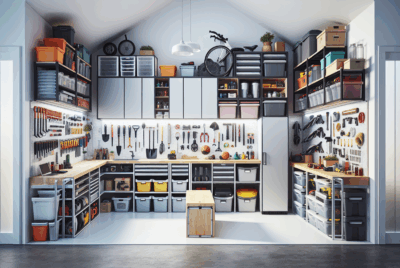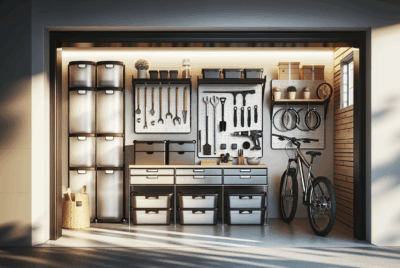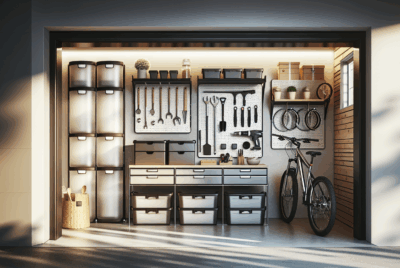Garage Decluttering: Expert Tips for a Spacious and Organized Space
As an Amazon Associate, I earn from qualifying purchases, at no additional cost to you. Disclaimer
Stepping into my garage used to feel like entering a maze. It was impossible to find what I needed in the clutter of tools, boxes, and forgotten items.
Decluttering your garage can transform this messy space into an organized, functional area.

When I started organizing, I realized that a systematic approach made the task manageable.
Breaking it down into steps, I sorted items, decided what to keep, and chose the right storage solutions. By taking charge of the mess, I gained not just space but peace of mind.
A clutter-free garage isn’t just about neatness; it’s about making life easier. With everything in its place, finding what I need is quick and painless. Taking the time to declutter has been a valuable improvement to my home.
The Importance of Decluttering Your Garage
Decluttering your garage can transform the space in useful ways. It makes room for new activities and reduces the chaos that comes with disorganization.
Benefits of a Decluttered Garage
After decluttering my garage, I found everything so much faster. I no longer waste time searching for tools or holiday decorations. A tidy garage means less stress when I need something quickly.
I also noticed an increase in space. With better organization, my garage could now fit both cars without squeezing them in tightly. I even had room for a small workbench.
Another benefit is safety. A clean floor means fewer tripping hazards. I feel at ease knowing that my family and I are less likely to get hurt.
Finally, decluttering helps protect items. With everything off the ground and in proper storage, items are less exposed to damage from dust and moisture. My belongings remain in better condition over time.
Planning Your Garage Decluttering Project
When I tackle decluttering my garage, I focus on setting clear goals, organizing items by category, and making thoughtful decisions about what to keep. This strategy helps me stay organized and avoid feeling overwhelmed.
Setting Achievable Goals
Starting with clear goals can make the decluttering process smoother. I begin by figuring out what I want to achieve. Maybe I want more space to park the car or organize tools better. Having specific goals helps me stay on track.
I often break these goals into smaller tasks. For example, I might tackle one corner of the garage first or aim to organize just the tools this weekend. By setting deadlines for each task, I keep my project moving forward.
Sorting Items by Category
Sorting my items into categories makes decluttering more manageable. I group things like tools, sports equipment, and holiday decorations. This way, I can easily see what I have and what I might need to get rid of.
Using labeled bins or boxes helps keep everything organized. I find it useful to make lists of each category. This helps me identify duplicates or items that are no longer needed.
Determining What to Keep
Deciding what to keep requires some thought. I ask myself if I’ve used the item in the past year or if it has any sentimental value. If not, it’s probably time to let it go.
For seasonal items like holiday decorations, I check if they’re broken or outdated. Keeping only useful things saves space and reduces clutter. I also consider donating items in good condition to make better use of space in my garage.
Effective Garage Organization Systems

Organizing a garage involves using smart storage systems. Vertical space, shelving units, and hanging storage solutions are key to keeping things tidy and accessible. Each of these methods plays a vital role in maximizing space and improving garage functionality.
Utilizing Vertical Space
I find that using the walls and ceiling in my garage can free up significant floor space. Wall-mounted racks and overhead storage systems help keep the area clutter-free. Tools and seasonal items can hang high, keeping them out of the way yet easy to reach.
Consider adding pegboards or slatwalls on garage walls. These boards hold hooks and shelves, letting me arrange tools and gear flexibly. Labeling spots for each item can help ensure everything returns to its place.
I also use overhead storage racks for items I rarely need, like holiday decorations. These racks attach to the ceiling, keeping bulky boxes off the floor and making use of a commonly wasted area.
Choosing the Right Shelving Units
Selecting the right shelving units can make a huge difference in garage organization. I always prioritize sturdy materials. Metal or heavy-duty plastic shelving can support heavier items and withstand wear. It’s essential to measure the space available to ensure a good fit.
Adjustable shelves are great because I can reconfigure them as my storage needs change. Resin shelving is ideal for damp environments, offering durability without rusting. For smaller garages, corner shelving units can leverage unused nooks.
Shelving needs vary, so sometimes it’s smart to combine different types. Units with lockable doors secure valuable items and keep products such as paint and chemicals out of children’s reach.
Innovative Hanging Storage Solutions
When floor and shelf space run out, hanging storage is my go-to solution. I use hooks and hangers for bikes, ladders, and garden tools. Items that lay flat can hang vertically, which is more efficient.
Magnetic strips are perfect for holding metal tools, keeping them visible and within easy reach. Installing bicycle lifts lets me store bikes overhead, freeing up additional room on the ground.
For smaller items and accessories, I rely on hanging baskets or wall-mounted bins. These solutions are versatile and make organization straightforward. Sliding track systems allow rearranging without hassle, providing a custom and adaptable space for whatever I need to store.
Tools and Equipment Organization

When organizing a garage, proper storage for gardening tools, sports equipment, holiday decorations, and winter gear is crucial. Finding efficient ways to store and access each type of item can keep your garage neat and make it easier to find what you need.
Storing Gardening Tools
I like to keep gardening tools easily accessible and organized. Using a pegboard is a great option, allowing me to hang tools like rakes and shovels on the wall. This keeps them off the floor and visible for easy grabbing.
Small tools, such as trowels and pruners, fit nicely in labeled bins or baskets. I might place these on shelves within reach. A sturdy tool rack can also come in handy for holding larger items securely.
It’s important to clean tools before storing them to prevent rust and damage. I always wipe them down after each use. This helps maintain their quality and lifespan. Grouping tools by type or use makes it simpler to find what I need quickly.
Organizing Sports Equipment
For sports equipment, I find that shelving units with bins work well. I use labeled bins to sort items like balls, helmets, and pads. This keeps similar items together and makes it easier to locate them.
A sports ball rack is another helpful solution. By placing balls in racks, I can avoid clutter on the floor and easily see what’s available. Wall-mounted hooks or racks are great for hanging items like bicycles or tennis rackets.
I always make sure to have a designated space for each sport. This way, I prevent mix-ups and keep everything neat. Using clear containers or bins allows me to quickly identify contents without opening them.
Managing Holiday Decorations and Winter Gear
Holiday decorations and winter gear need special attention in the garage. I prefer using large plastic bins with lids to store holiday items like lights and ornaments. Labeling the bins by holiday type helps keep them organized.
For winter gear, I hang coats and snow pants on sturdy hooks or a coat rack. This keeps clothing items in good condition. Accessories like gloves, hats, and scarves fit well in labeled bins or baskets.
It’s crucial to place these items where they are easy to access. I store frequently used gear, like shovels and ice melt, near the garage entrance. This way, I’m ready for quick access during harsh weather conditions.
Decluttering Tips and Techniques

When I tackle garage decluttering, I find that using trash bags and storage bins, hooked walls, and labels helps organize items effectively. These tools make it easier to manage clutter and simplify finding items later. Here’s how I do it.
Effectively Using Trash Bags and Storage Bins
Trash bags and storage bins are essential for sorting. I start by categorizing items into “keep,” “donate,” and “dispose” piles. Trash bags are perfect for things to throw away or donate. Having sturdy bags lets me carry them out without a mess.
For items I plan to keep, I use storage bins. Clear bins help me see what’s inside, saving time later. I label each bin by category, like “tools” or “seasonal decor.” Stackable bins are a great space-saver and make the garage look tidy. By regularly sorting through these bins, I prevent clutter buildup.
Implementing Wall Hooks for Additional Storage
Wall hooks are a game-changer for freeing up floor space. I install these on sturdy walls, allowing me to hang items like bikes, tools, and garden equipment. This clears up room and keeps things accessible.
I choose hooks that can hold the weight of each item safely. Adjustable hooks work well for various objects. For lighter items, smaller hooks do the job. Keeping similar items together on the hooks improves organization and efficiency.
Labels and Inventory for Easy Item Retrieval
Labels are key for understanding where everything is. After organizing with bins and hooks, I ensure each spot is clearly marked. I use a label maker or permanent markers for this task. Including a brief description makes it clear what each container or area holds.
Inventory lists help me track what I store. By keeping a simple list of items and their locations, I avoid unnecessary duplicates. This inventory can be digital or a paper list hung visibly in the garage. Keeping it updated is important for maintaining order and saving time during future searches.
Maintaining a Garage Organization
Keeping my garage organized requires commitment and smart strategies.
I focus on creating a maintenance routine and staying aware of potential cluttering habits.
Creating a Routine for Regular Upkeep
Maintaining the organization starts with setting a simple routine.
I dedicate a little time each week to clean and put things back in their place.
It’s important to remind myself to avoid piling items, which can quickly lead to clutter.
I make a checklist of tasks that need to be done regularly. Examples include:
- Sweeping the floor
- Inspecting storage areas
- Reorganizing misplaced items
These small steps make a big difference.
Labeling boxes and storage bins are also useful. This simplifies finding and returning items, reducing the likelihood of mess.
By making small efforts regularly, I keep the space tidy.
Avoiding Common Recluttering Pitfalls
Understanding the potential pitfalls helps me avoid them.
Accumulating items I no longer need is a frequent issue. I regularly assess what I have to decide if it still serves a purpose.
When I’m tempted to store something “just in case,” I ask myself if I have used it in the last year. If not, it might be time to let it go.
I also recognize the importance of involving family in the decluttering process.
Ensuring everyone knows where things go minimizes mix-ups. Sometimes, seeking advice from a professional organizer offers new perspectives and practical solutions.
This helps me maintain an organized garage that’s efficient and clutter-free.
Moving Forward: Selling, Donating, and Disposing
Once I’ve decluttered, it’s time to handle the items I don’t need. I must plan how to sell, donate, or dispose of these items properly. Each choice has its benefits and requires different steps, which I’ll detail below.
Planning a Garage or Yard Sale
A garage or yard sale is a great way to earn some extra money.
I need to pick a good date, typically a weekend when many people are free.
Advertise in the local paper or on social media. Clearly price items to avoid confusion.
I should set up the sale in an organized way, grouping similar items together.
A well-organized sale makes it easier for buyers to find what they want.
Providing a variety of payment options, like cash and digital payments, can help attract more buyers.
I can also offer special deals, such as discounts for buying multiple items. This helps clear more space.
Ensuring everything is cleaned and in good condition increases the chances of sale.
Options for Donating Items
For items that won’t sell, I can donate to local charities. Many organizations welcome things like clothing, furniture, and toys.
Before donating, I need to check what is accepted. Some charities may have restrictions on items or need them to be in certain conditions.
I should also ensure that the items are clean and functional. Donating things that are in good shape helps those in need.
Calling ahead to see if the charity can pick up donations can save me time and effort.
Donating not only helps reduce clutter but also supports the community. There might even be a tax benefit if I keep donation receipts.
Proper Disposal of Unwanted Items
Items that cannot be sold or donated should be disposed of responsibly.
I should separate recyclables from trash. Many electronics need special handling due to hazardous materials, so I must check local regulations for proper disposal methods.
Some communities have bulk waste pickup days or recycling events. Participating in these helps dispose of large items correctly.
If I’m unsure about where to take certain things, local waste management centers can provide guidance.
In some cases, hiring a junk removal service might be the best option. They handle everything and ensure items are dealt with properly, saving me time and effort.
Frequently Asked Questions
Decluttering a garage can seem like a big task, but with the right strategies and some creative ideas, it can be manageable. From cost considerations to expert tips, understanding these factors can help make the process smoother.
What are effective strategies for decluttering a garage?
I recommend starting by sorting items into categories: keep, donate, sell, and trash.
Be honest about what you really need. Use clear storage bins for visibility and stack items vertically to save space.
What steps should be included in a garage decluttering checklist?
First, set a realistic schedule. Next, sort items and take everything out. Clean surfaces thoroughly.
Finally, organize items into labeled bins or shelves for easy access. Regularly revisit this checklist to keep the garage organized.
Can you suggest some creative ideas to organize a cluttered garage?
Consider using pegboards for tools and wall-mounted racks for bikes. Overhead storage can maximize space by holding rarely-used items. Magnetic strips are great for keeping metal tools handy and organized.
What tips do experts recommend for those feeling overwhelmed by garage cleaning?
Experts advise breaking the task into smaller, manageable parts. Focus on one section at a time.
It helps to set short time limits, like 15 to 30 minutes, to prevent burnout.
How can you efficiently organize a garage to maintain a long-term decluttered space?
Organize items by frequency of use, with the most-used items in easily accessible spots.
Establish a routine for putting things back in their assigned places, and set a regular schedule for reviewing stored items.
What should one expect to pay for a professional garage decluttering service?
The cost depends on garage size, level of clutter, and specific services needed.
On average, you might expect prices to range from $200 to $500 and more for larger spaces or extensive organization tasks.



